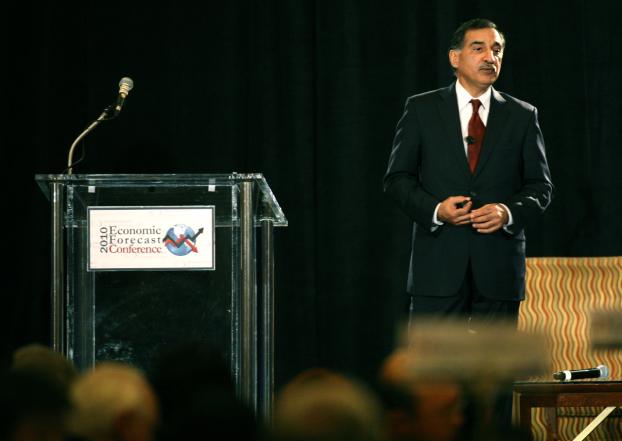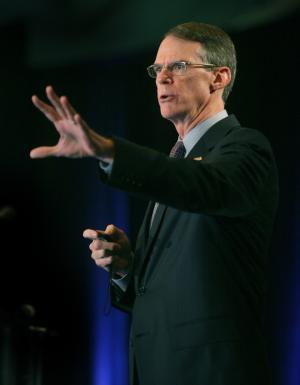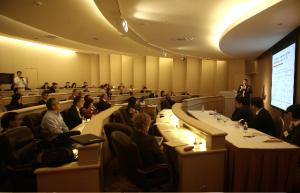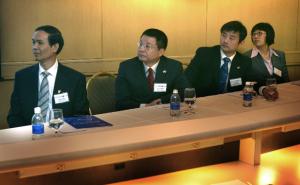 Caption: Anil Puri, dean of Mihaylo College of Business and Economics, discusses the national and local economic situation Oct. 28 at the 2010 Economic Forecast Conference sponsored by Mihaylo and the Orange County Business Council.Download Photo
Caption: Anil Puri, dean of Mihaylo College of Business and Economics, discusses the national and local economic situation Oct. 28 at the 2010 Economic Forecast Conference sponsored by Mihaylo and the Orange County Business Council.Download Photo
Inch by Inch
Economists Predict No Relapse, Slow Progress
“There is an old Chinese proverb that says ‘may you live in interesting times.’ If these are not interesting times, I don't know what is,” began Anil Puri, dean of Mihaylo College of Business and Economics, as he kicked off the Oct. 28 Economic Forecast co-sponsored by the Orange County Business Council and the business college. The forecast was made before a sold-out audience of approximately 1,000 local business leaders, community leaders and educators.
 Caption: Richard Davis, U.S. Bancorp CEO, discussed the recovery and banks during the 2010 Economic Forecast Conference Oct. 28. Photo by Greg Andersen
Caption: Richard Davis, U.S. Bancorp CEO, discussed the recovery and banks during the 2010 Economic Forecast Conference Oct. 28. Photo by Greg Andersen
“It is the opposite of the simple, same old-same old, business,” he explained. “Facts don't fit our notion of reality … This recession has turned everything upside down. Its now called the ‘Great Recession’ because of the severity of what has transpired."
The veteran forecaster noted that although the ‘Great Recession’ technically ended in summer 2009, the rebound in economic activity has been weak and “uninspiring with below-trend growth, above-average unemployment and a myriad of headwinds that have severely constrained growth.”
But despite the slowdown, Puri and his associate Mira Farka, stated that they did not see a relapse into recession. Instead, they noted, the economy should continue to heal in a “recovery of two halves” in which growth in the second half would move forward “above stall speed, but still too slow to make a significant difference to the jobless rate. … The recovery should eventually become self-sustained and gradually pick up a bit more steam towards the end of 2011/early 2012.”
Three elements to what the CSUF economists see happening in the second half:
• Dragging fundamental forces (labor, consumption, household finance, housing market);
• Dimming bright spots (fiscal and monetary policy, investments, production, global environment); and
• Bright spots (corporate and financial sectors, inflation).
Puri and Farka concluded: “The U.S. economy should continue to grow at an uneven and modest pace over the near term. The recovery will bear a closer resemblance to a mild recession than to an expansion. Consumer spending, labor markets and housing will remain a drag over the next six quarters and may not return to their full potential for a few years, as household repair their damaged balance sheets — a process that takes years to complete. A few bright spots should help support growth: corporate profitability is at an all-time high, the financial sector is on a much stronger footing and inflation remains well contained.”
For Orange County and Southern California, the economists report modest improvements in the private sector job growth but a longer time for local and state governments to get back on track. “In fact, we expect a continuing decline in government jobs over the next two years. Only when tax revenues get a boost from a more robust economic growth will the state and local fiscal situation improve.”
The Economic Forecast Report, prepared by the college’s Institute for Economic and Environmental Studies under Puri’s direction, contains information on the global economy and national forecasts.
As part of the economic forecast conference, Richard Davis, U.S. Bancorp CEO and a Cal State Fullerton business alumnus, made a presentation of a $500,000 grant for an economic empowerment program to his alma mater.
During his part of the forecast presentation, the banker urged the audience to remember that there would be a recovery. Using basketball analogies, he likened the recovery to “halftime … we're in the moment and we need to believe and move forward with confidence that things will get better.
“I have no science, no special data, but I am 100 percent sure we as a country can still achieve great things.”
Oct. 29, 2010
 China's current economic environment, U.S. and China business opportunities and the development of the Chinese Financial system were the topics of a forum following the "2010 Economic Forecast" Oct. 28.
China's current economic environment, U.S. and China business opportunities and the development of the Chinese Financial system were the topics of a forum following the "2010 Economic Forecast" Oct. 28. Photos by Greg Andersen
Photos by Greg Andersen